A report finds the unfunded debt of Republican-controlled Texas is closer to that of Democrat-controlled states like California and New York, rather than Republican-controlled states like South Dakota and Florida. This report arrived while a number of Texas Gov. Greg Abbott’s coronavirus mandates are still in effect, resulting in lower economic activity, and Texas is approaching the 2021 legislative session, in which lawmakers must pass a balanced budget for the next biennium.
Truth In Accounting, an organization that believes “taxpayers and citizens deserve easy-to-understand, truthful, and transparent financial information from their governments,” found the state would have to take over $11,000 more from each taxpaying Texan to pay off all its debts.
TIA conducted a study that ranks each of the 50 states in America based on the size of each state’s outstanding debt and resulting surplus or burden per taxpayer, using data from each of the state’s certified annual comprehensive financial reports (CAFRs) from 2019.
The burden is calculated by dividing up how much additional money would be needed from each taxpayer to pay all of a state’s outstanding debt. If a state were to pay all of its bills and still have money left over, that would be considered a surplus for the taxpayers.
States that don’t have the money to pay their bills are called “sinkhole states,” while those that do are called “sunshine states.”
Texas is identified as a “sinkhole state,” earning a D grade and ranked 34 out of the 50 states in terms of ability to pay its debts, as well as debt per taxpayer. This puts Texas closer to deep blue Democrat states like New York (41), California (43), and New Jersey (50), which is ranked as the worst “sinkhole state,” with an estimated per taxpayer burden of over $57,000.
The top “sunshine state” in America is Alaska, ranking at No. 1 with an estimated per taxpayer surplus of over $77,000. South Dakota, where Kristi Noem serves as governor, is ranked 6, while Florida, where Ron DeSantis serves as governor, is ranked 16.
Texas is also found to be among the 39 states without enough money to pay its bills and would need to raise an additional $96.7 billion to pay off all debts. That equals a debt burden of $11,300 per taxpaying Texan.
“This report shows that Texas went into the coronavirus pandemic in poor fiscal health, and it will probably come out of the crisis even worse,” it reads.
TIA’s report finds much of Texas’s financial woes are coming from “unfunded retirement obligations” that have grown year after year. “Of the $275 billion in retirement benefits promised,” the report reads, “the state did not fund $67.1 billion in pension and $72 billion in retiree health care benefits.”
TIA projects the Lone Star State will lose $24 billion in revenues because of the Chinese coronavirus situation. “The uncertainty surrounding this crisis makes it impossible to determine how much will be needed to maintain government services and benefits, but Texas’ overall debt will most likely increase,” the report adds.
Texans who are concerned about their tax burdens may contact their state representative, state senator, and Gov. Greg Abbott.
This article has been updated since publication.





